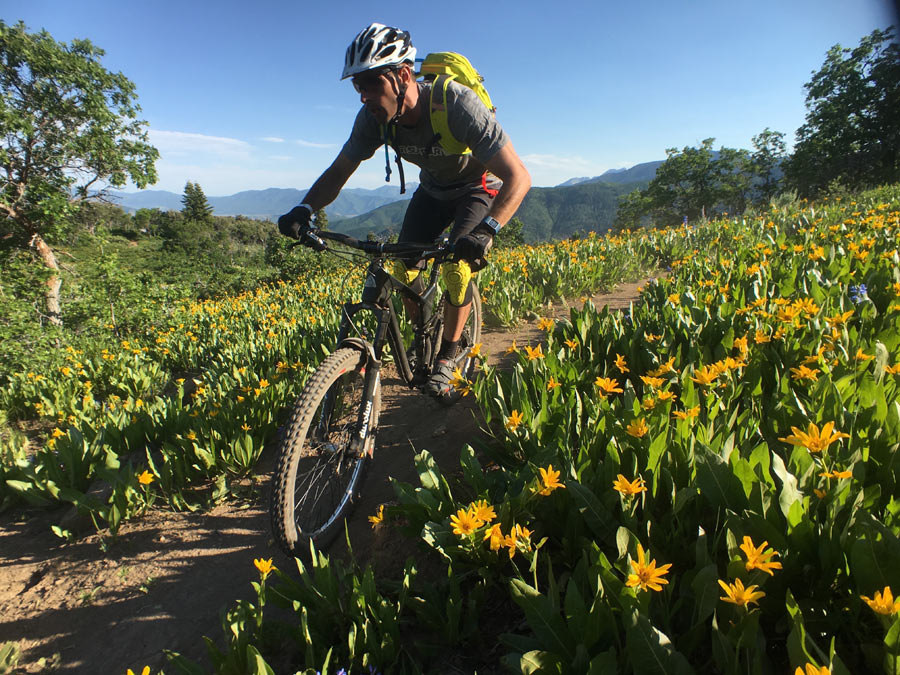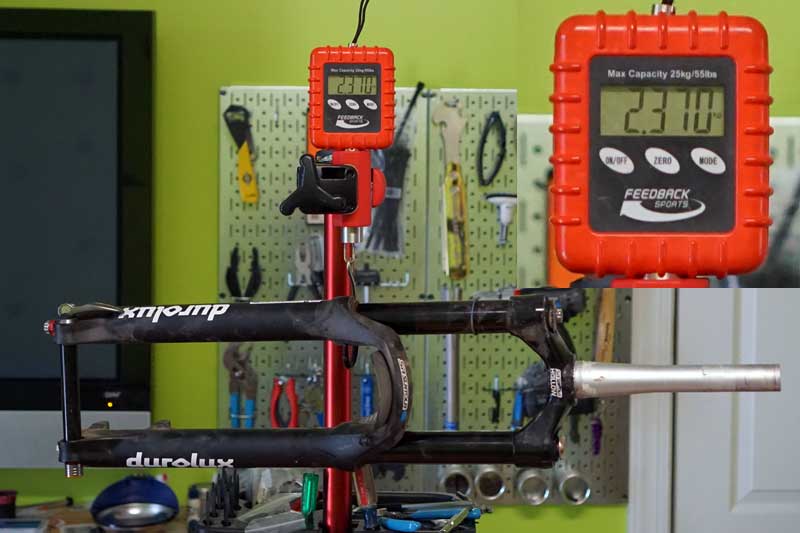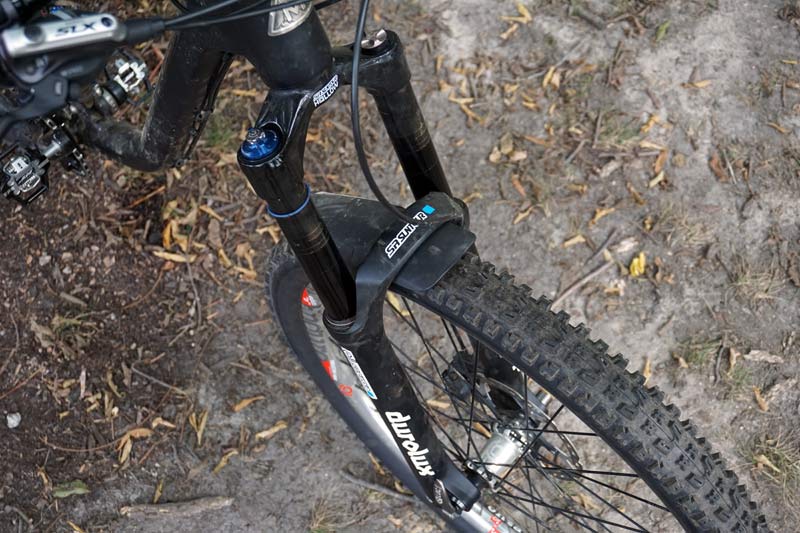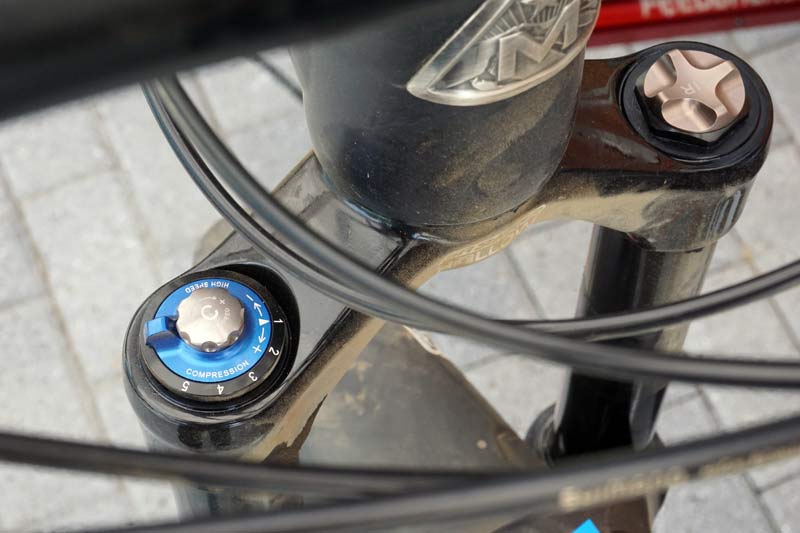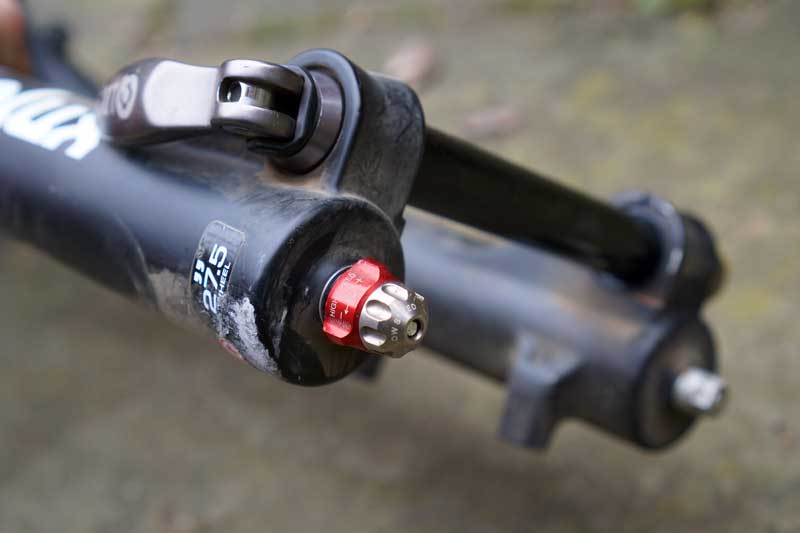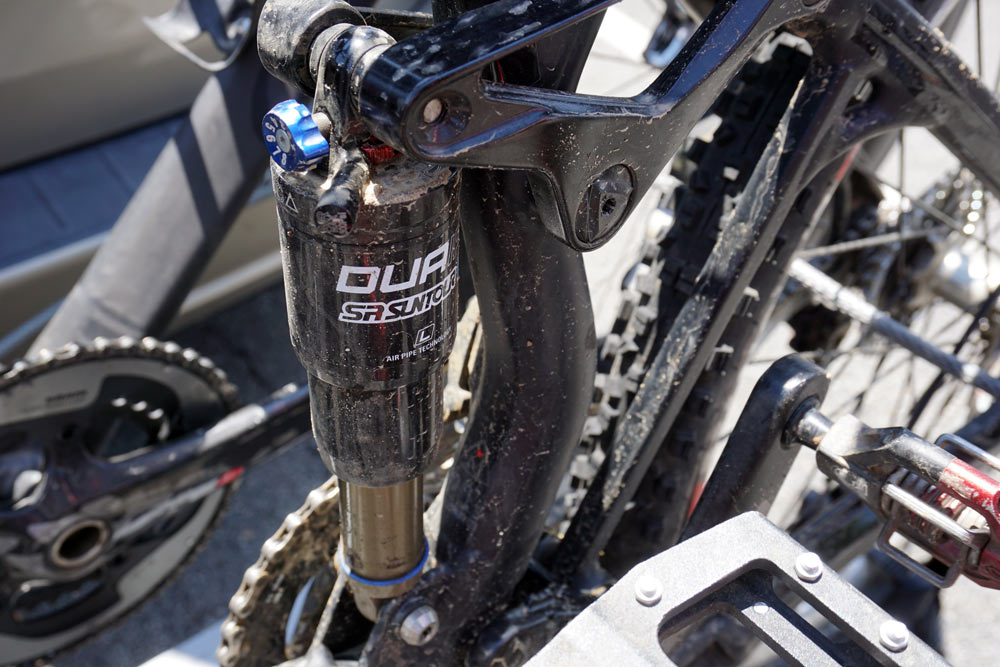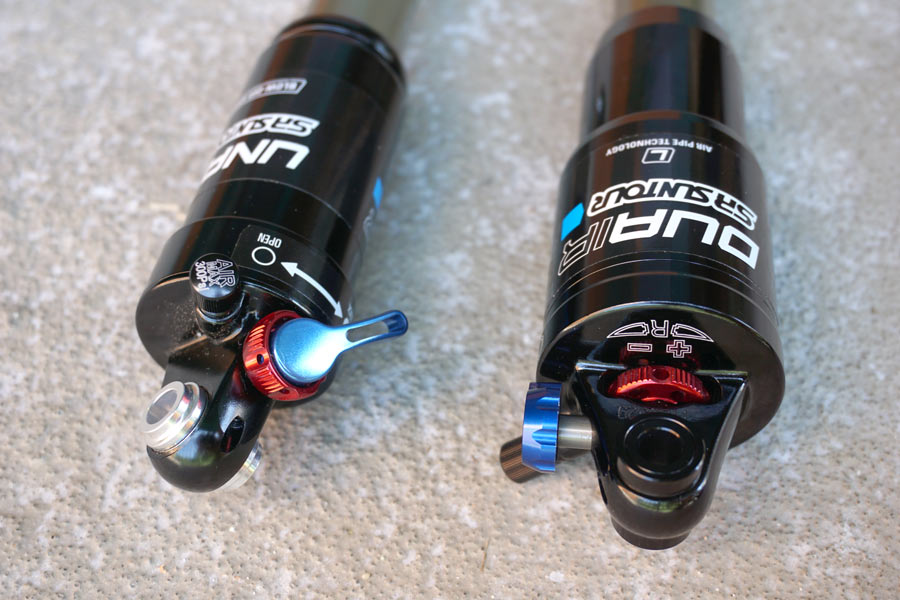In 2015, I attended the SR Suntour Durolux R2C2 enduro suspension fork launch at Mountain Creek in New Jersey. It was a big announcement for them, introducing new technology on an all-new chassis for a new wheel size. And the proving grounds they chose were aggressive and gnarly, chewing through tires at an alarming pace.
The complete tech story was covered in great detail in our launch coverage, but here’s the short of it: The 2016 Durolux is for 27.5″ wheels only, uses bigger 36mm stanchions and a 20mm thru axle, and has completely new internals designed to not only perform like a downhill fork, but also give you complete external control over its damping characteristics. That’s because the R2C2 cartridge puts high and low speed controls for both compression and rebound in easy reach. They also gave it easy to adjust air volume clips that double as travel adjustment parts, just put them in a different spot. Throw in a custom, pre-installed fender and it should be the ultimate enduro weapon. Here’s how it fared after almost of year of proper testing…
DUROLUX ACTUAL WEIGHT
The fork, with R2C2 cartridge installed and steerer tube cut to a reasonable length for an XL sized mountain bike, weighs in at 2,370g (5.22lb). That’s with the fender installed, axle inserted and a star nut…ready to ride.
I mention that it’s weighed with the new cartridge because when I brought it home from the launch camp, it had the RC2 cartridge in it. Our original test part was preproduction and sprung a leak while on the mountain, so they swapped in the base-level substitute to keep us riding. A few months later, production parts were ready and we swapped in the R2C2. True to SR Suntour’s QSP (Quick Service Product) design, it was under 30 minutes to get the old cartridge out and the new one in. It’s performed flawlessly since.
DUROLUX RIDE REVIEW
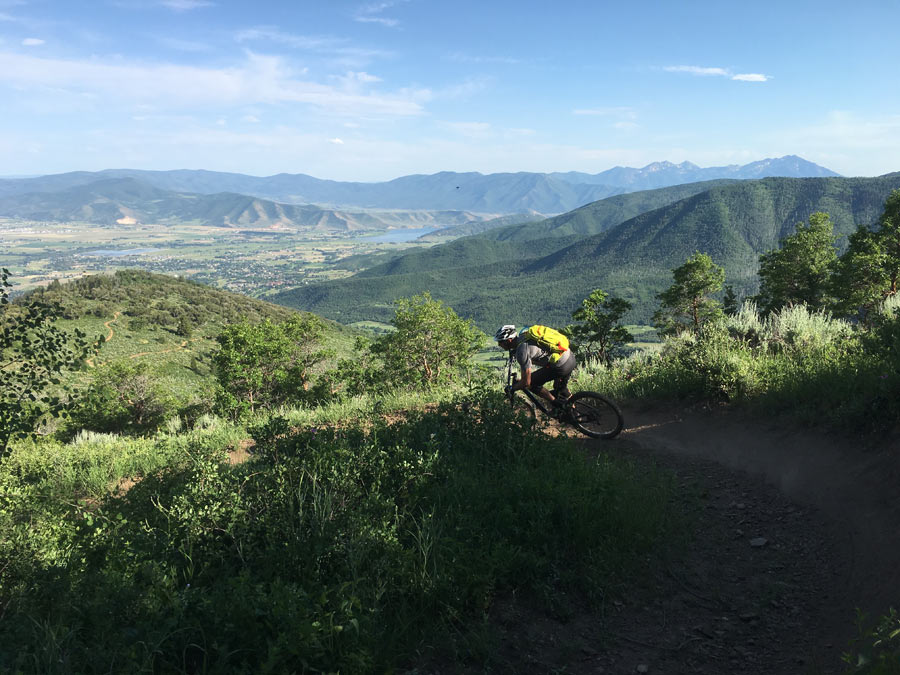
The fork’s been ridden all around, but two of the more appropriate trails were Devou Park Trails in KY, which has a few rocky and high speed descents with water bars and humps that server as booster jumps if desired, and the epic descent down Wasatch Over Wasatch through Pine Canyon in Wasatch Mountain State Park, UT. The latter is a miles upon miles long steady descent into Midway with high speed straights, bermed switchbacks, drops, rocks and amazing riding. Carry speed and it’s like combining a day’s worth of timed enduro sections into a single run; easily an hour of descending. That’s a solid 12 miles of minimal pedaling and maximum stoke. And plenty of time to overheat suspension oil or reveal any weaknesses. We did stop for a few pics up top, but after that it was nothing but brake burning and tire squirming good times all the way down.
My test rig was the Marin Attack Trail 8, a bike proven on the enduro circuit. The fork’s 160mm travel paired nicely with the bike’s 150mm rear end. The Durolux starts out as a 180mm fork, but can be reduced to 170mm or 160mm via spacers. That extreme max travel is why they’ve stuck with a 20mm thru axle, but they sell reducers to let you run a 15mm TA wheelset on the fork.
The all black color scheme looks mean, and this fork means business. The 36mm stanchions and hollow crown were rigid to keep steering predictable and the lowers sliding smoothly throughout the rough. Performance never faded even when my arms and hands started to. Considering SR Suntour has some of the best riders in the world racing this fork (and winning on it), chances are darn good you and I will never fully push it to its limits. So, the chassis is dialed and the internals are beyond good. The last reason to go with the R2C2 is the dual external compression and rebound controls.
R2C2 puts separate high and low speed compression and rebound knobs on the fork, letting you fine tune the damping to meet your needs. Combine that with air volume adjustment spacers and you’ve got virtually every user adjustable option you could want. Of course, this means you should know how to use all those dials (check our Suspension Setup Guide – free PDF download), or you can ruin the ride. This fork is firmly in the pro level component realm. It rewards the patient rider that’s willing to take the time to dial it in run after run.
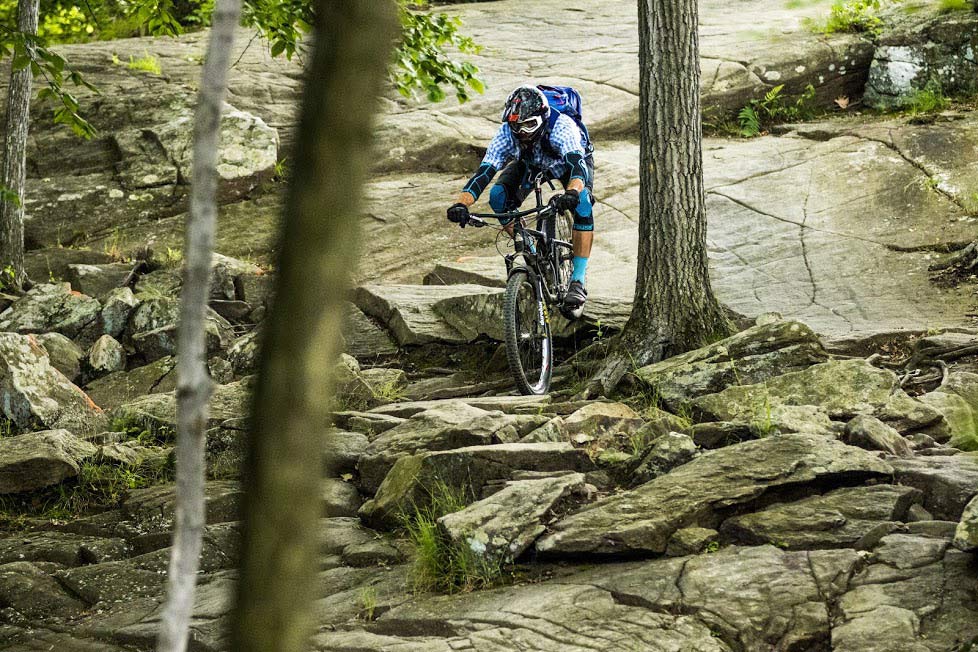
I’m very impressed with the new Durolux. Even in RC2 ($700), it’s good, but all of the advancements in the R2C2 ($800) cartridge put it in the realm of super forks. If you’ve been looking at the Rockshox Pike or Fox 36, put this one on your list, too. For now, it’s only available in 27.5″ and with 100mm axle spacing. A Boost 29er version should be coming in July 2017, with a Boost 27.5 model possibly following a little later.
DUAIR REAR SHOCK
Alongside the Durolux I tested the SR Suntour DuAir rear shock ($250). It’s an air shock with an extra volume canister over the main air chamber, hence the “Dual Air” naming scheme. There’s also an UnAir without the volume chamber. Check the full tech rundown on these shocks here, there’s a lot more going on than I’ll cover here and its worth a look. They offer multiple size sleeves to let you fine tune the volume. Compared to the UnAir’s single-throw lockout lever, the DuAir adds a stepped compression control knob. It also puts the rebound control knob in a harder spot to reach, which means you’ll likely need to pull an allen wrench out to stick into the holes on the knob. With gloves on, I couldn’t get my fingers in there to turn it.
The rebound adjustment range is insane. On one end, it basically held the shock fully compressed, not letting it return at all. At the other end, it’s blazing fast. The benefit to this much range is that if you’re a heavier rider and need slower rebound to counteract higher air pressure, it’s there. Each click has a subtle but noticeable affect on rebound speed.
Inside, there’s a shim stack that’s usually tuned to the model bike it’s going on. Functionally, the shock worked fine, but was not specifically tuned for the Marin I was testing it on, it just happened to be the one on their demo truck that fit my bike. It never felt 100% amazing. Never bad -it’s not that I ever had any real specific complaints, especially after I found a rebound speed I liked- but it just didn’t bring the bike to life like a good shock can. From a technical standpoint,its design is impressive, so I want to give it the benefit of the doubt that a factory tune for a specific model should be better. Dat fork, tho… All. Day. Long.
